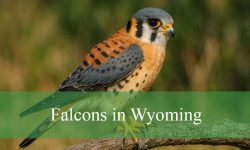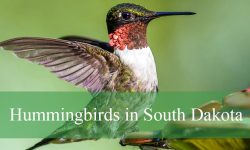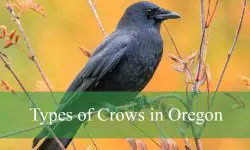Across Idaho, a diverse array of hawks patrols the skies, from the broad-winged Red-tailed Hawk to the swift and nimble Sharp-shinned Hawk. These raptors are admired for their sharp eyesight, powerful flight, and skilled hunting.
The state’s diverse habitats, including open grasslands, sagebrush plains, wetlands, and mountain forests, support both resident and migratory hawks. Birdwatchers can spot many species year-round, while some appear only during migration or winter months.
Whether perched on a fence post or gliding high above the Snake River Plain, each hawk offers a unique glimpse into Idaho’s wild landscapes. Observing these raptors provides both excitement and insight into the state’s rich avian biodiversity.
Different Types of Hawks Found in Idaho
Red-tailed Hawk
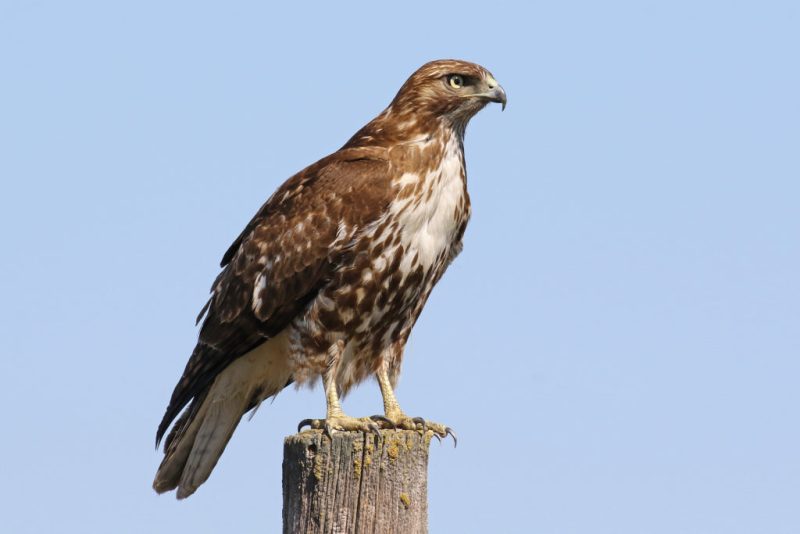
The Red-tailed Hawk is one of the most widespread and recognizable raptors in Idaho. This large buteo is famous for its reddish-brown tail, which contrasts with its mottled brown back and pale underparts. Its broad wings and sturdy body allow it to soar effortlessly across open skies, often perching on poles and trees to scan the ground below for prey.
In Idaho, the Red-tailed Hawk thrives in a wide range of habitats, including grasslands, deserts, agricultural fields, and forest edges. Its adaptability makes it one of the most common hawks spotted throughout the state. Birdwatchers often hear its distinctive raspy scream, a sound frequently used in movies to represent any eagle or hawk.
Red-tailed Hawks are opportunistic hunters, feeding on small mammals such as rabbits, voles, and squirrels. They also prey on snakes, birds, and even carrion when food is scarce. Their sharp talons and keen eyesight make them formidable predators across Idaho’s landscapes.
These hawks are year-round residents in Idaho, but northern populations may migrate south during the colder months. During breeding season, they construct large stick nests high in trees or on cliff ledges, where they raise two to three chicks each year.
Swainson’s Hawk
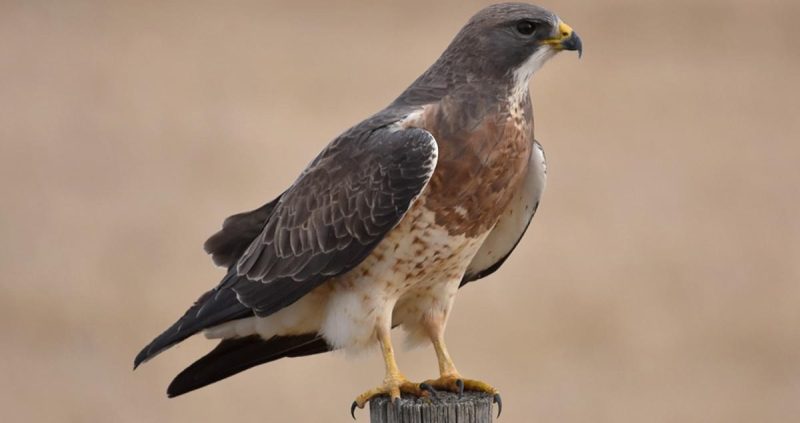
Swainson’s Hawk is a long-winged raptor that makes its summer home in Idaho’s open country. It is distinguished by its slim body, long pointed wings, and dark bib across the chest, which contrasts with its lighter belly. In flight, its wingtips often resemble those of a falcon, helping birders identify it against the wide western skies.
This hawk prefers grasslands, sagebrush steppe, and agricultural regions where prey is abundant. It is particularly common in southern Idaho, where open fields offer ideal hunting grounds. Unlike some other hawks, Swainson’s Hawks often perch on fence posts and low snags, keeping watch for prey.
Their diet is unique because it changes with the season. In spring and summer, they hunt rodents, reptiles, and small birds. However, during late summer and migration, they consume massive amounts of insects such as grasshoppers and crickets, sometimes gathering in large flocks to feed.
Swainson’s Hawks are highly migratory and travel thousands of miles to wintering grounds in South America. Each fall, they form spectacular kettles of hundreds of birds, soaring southward over Idaho’s skies before embarking on their long journey.
Rough-legged Hawk

The Rough-legged Hawk is a winter visitor to Idaho, traveling from the Arctic tundra to spend the colder months in the state. It is one of the few hawks with feathered legs all the way down to its toes, an adaptation for surviving freezing northern climates. Its plumage can vary greatly, but it often shows a pale head, dark belly band, and distinct black patches at the bend of the wings.
This species favors open habitats such as grasslands, agricultural fields, and sagebrush flats during winter in Idaho. Unlike many other hawks, it frequently hovers in place while hunting, using its strong wings and keen eyesight to spot prey below.
Rough-legged Hawks primarily feed on small mammals like voles, mice, and lemmings, which make up the bulk of their diet. When rodent populations are low, they may also consume small birds and carrion. Their hunting style is deliberate, often perching on fence posts and power poles before gliding low across fields.
Since they only appear in Idaho during winter, these hawks add seasonal excitement for birdwatchers. By late spring, they return to the Arctic, where they breed on cliff edges and tundra bluffs, raising their young in the brief but productive northern summer.
Ferruginous Hawk
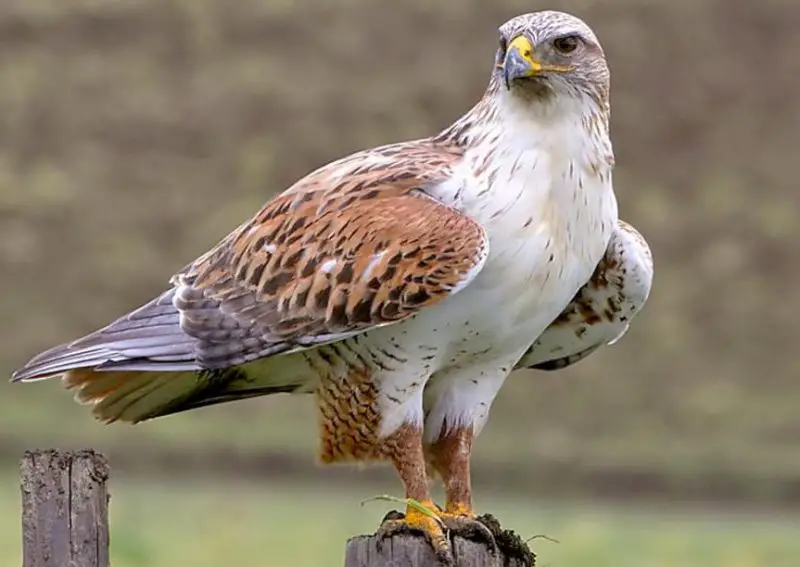
The Ferruginous Hawk is the largest hawk in North America and an impressive sight in Idaho’s open country. Its name comes from the rusty, ferruginous coloration on its legs and back, while its underparts remain mostly white. With long, broad wings and a wide gape, it is built for soaring effortlessly over prairies and deserts.
This hawk prefers open grasslands, sagebrush steppe, and arid regions of southern Idaho. It avoids forests and mountainous terrain, choosing instead habitats where it can easily spot prey. Unlike Red-tailed Hawks, Ferruginous Hawks are less likely to perch on trees and more often rest on the ground or low mounds.
Their diet mainly consists of medium-sized mammals such as rabbits, prairie dogs, and ground squirrels. They are powerful hunters that can capture larger prey than most other hawks in Idaho. They also occasionally eat reptiles and birds, depending on availability.
Ferruginous Hawks are breeding residents in parts of Idaho, often nesting on cliffs, rock outcrops, or even artificial platforms. Because of their large size and rarity, spotting one in the wild is a memorable experience for birdwatchers.
Cooper’s Hawk
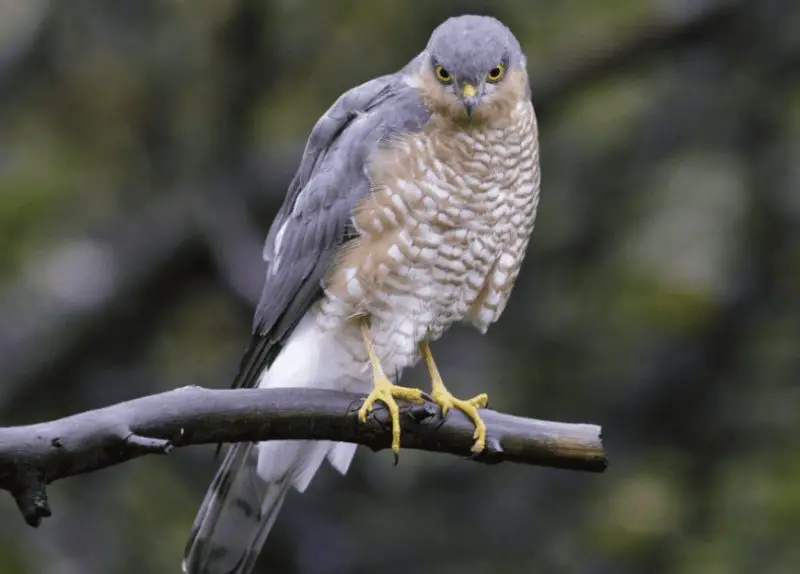
Cooper’s Hawk is a medium-sized accipiter that inhabits both rural and urban areas of Idaho. It has a sleek body, rounded wings, and a long tail with dark bands, making it well-adapted for maneuvering through forests. Adults display bluish-gray upperparts and rufous barring across the chest, while juveniles are streaked brown and white.
This hawk thrives in wooded habitats, ranging from mountain forests to suburban neighborhoods. It often surprises backyard bird enthusiasts by hunting near bird feeders, where songbirds gather in large numbers. Its stealth and agility make it an expert ambush predator.
Cooper’s Hawks primarily feed on medium-sized birds such as pigeons, doves, starlings, and jays. They occasionally take small mammals like squirrels and chipmunks, but their preference for birds is unmistakable. They are known for dramatic high-speed chases through trees, showcasing incredible flying skills.
These hawks breed widely across Idaho, building stick nests high in coniferous or deciduous trees. They are protective parents, often diving at intruders that come too close. With their adaptability, Cooper’s Hawks have become one of the most commonly observed forest hawks in the state.
Sharp-shinned Hawk
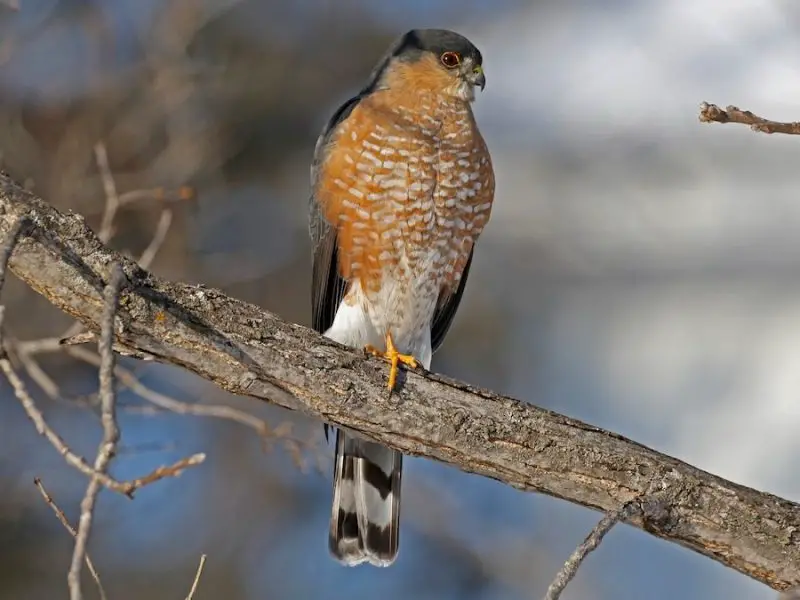
The Sharp-shinned Hawk is the smallest hawk in Idaho, but despite its size, it is an agile and determined hunter. Adults are slate-blue above with reddish barring across the chest, while juveniles are brown with vertical streaks on the underparts. Its long, narrow tail with squared tips and short, rounded wings help it maneuver effortlessly through dense trees.
These hawks are most often found in forested regions, particularly coniferous and mixed woodlands. In Idaho, they can also be spotted during migration, passing through open areas and even suburban neighborhoods where backyard feeders attract songbirds. Their flight is quick and darting, making them difficult to follow with the eye.
Sharp-shinned Hawks feed primarily on small birds, such as sparrows, finches, and warblers. They often ambush prey by perching silently in cover or pursuing them in dramatic, high-speed chases through the trees. Their hunting style requires both precision and agility, which explains their preference for woodland habitats.
Although not as common in urban areas year-round, Sharp-shinned Hawks are regular migrants in Idaho and can occasionally be seen in winter. They build nests in dense forest canopies, hidden away from predators, where they raise two to five chicks during breeding season.
Northern Goshawk
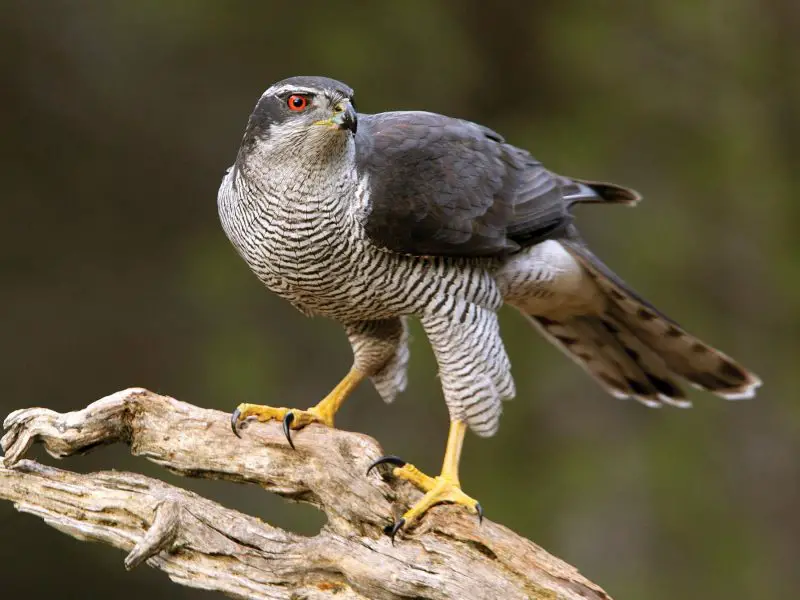
The Northern Goshawk is a powerful and secretive forest hawk that inhabits Idaho’s mountain woodlands. Larger than both Sharp-shinned and Cooper’s Hawks, it has broad wings, a long tail, and a bold white stripe over its eyes, giving it a fierce look. Adults are bluish-gray above with fine barring below, while juveniles are brown with streaky underparts.
This hawk prefers remote coniferous and mixed forests, where it hunts with both strength and agility. It is seldom seen in open areas, making it a prized sighting for birdwatchers in Idaho. Its ability to weave quickly through trees while pursuing prey shows its remarkable adaptation to forested environments.
Northern Goshawks prey on medium-sized birds such as grouse, crows, and woodpeckers, along with mammals like squirrels, rabbits, and hares. Unlike smaller accipiters, they can tackle relatively large prey, using their powerful talons and speed to overpower victims.
During breeding season, goshawks build large stick nests high in mature trees. They are known for being highly defensive around their nesting sites, often diving at humans or animals that get too close. In Idaho’s wilderness, their elusive behavior makes them one of the most fascinating hawks to encounter.
Broad-winged Hawk

The Broad-winged Hawk is a small buteo that is considered an uncommon migrant in Idaho. It has broad, rounded wings and a short, squared tail with bold black-and-white bands. Adults are brown above and pale below with horizontal chest barring, while juveniles are streakier.
This hawk favors woodlands near rivers and wetlands, especially during migration. In Idaho, it is most often seen passing through in spring or fall, sometimes in small groups as part of their long journey south. Because it is much more common in the eastern United States, spotting one in Idaho is considered a special treat.
Broad-winged Hawks feed on a variety of prey, including small mammals, frogs, lizards, snakes, and large insects. They hunt by perching quietly in the woods and swooping down on unsuspecting prey, a style that contrasts with soaring buteos like the Red-tailed Hawk.
One of the most remarkable things about Broad-winged Hawks is their migratory behavior. In autumn, they join massive flocks called “kettles,” numbering in the thousands as they travel to Central and South America. While these spectacles are rare in Idaho, they highlight the species’ incredible migratory instincts.
Northern Harrier
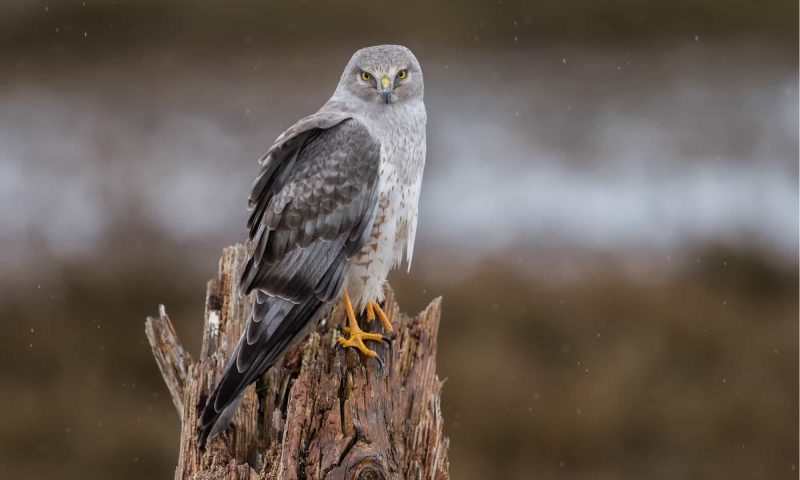
The Northern Harrier is a slender, long-winged hawk easily identified by its low, gliding flight over open fields. Males are gray above with white underparts, while females and juveniles are brown with streaking. Both sexes display a distinctive white rump patch, which is one of the best field marks for identification.
In Idaho, Northern Harriers are most commonly found in wetlands, grasslands, and agricultural areas. Unlike most hawks that hunt from perches or high soaring, harriers fly low to the ground in a graceful, tilting flight pattern, scanning for movement below.
Their diet mainly consists of small mammals such as voles, mice, and shrews, though they also hunt small birds, reptiles, and large insects. Unique among hawks, they use both vision and hearing to detect prey, thanks to their owl-like facial disk that helps capture sound.
Northern Harriers nest on the ground, building concealed nests in tall grasses or reeds. Because of this, they are vulnerable to habitat loss and agricultural changes. Still, they remain a widespread and recognizable hawk across Idaho, especially in open country.
Harris’s Hawk

The Harris’s Hawk is a rare visitor in Idaho, best known as a resident of the southwestern United States and Mexico. It has striking plumage with dark brown body feathers, chestnut-colored shoulders and thighs, and bold white markings on the rump and tail. Its long legs and sharp talons make it a capable hunter.
What makes Harris’s Hawks especially unique is their social behavior. Unlike most hawks that hunt alone, Harris’s Hawks are cooperative hunters. They form small family groups that work together to flush out and capture prey, an adaptation that increases their hunting success in open desert habitats.
These hawks primarily feed on rabbits, hares, and other medium-sized mammals, though they also take birds and reptiles. Their group hunting strategy allows them to subdue larger prey that would be too challenging for a single hawk.
In Idaho, Harris’s Hawks are only seen occasionally and are considered very rare. Birdwatchers who encounter one are witnessing an unusual event, as the species’ natural range lies far to the south. Despite this, their social nature and striking appearance make them one of the most fascinating hawks recorded in the state.
Best Time and Places to Spot Hawks in Idaho
Idaho offers excellent hawk-watching opportunities year-round, but the best times depend on species. Spring (March–May) and Fall (September–November) are peak migration periods when Broad-winged Hawks and Swainson’s Hawks pass through. Winter (December–February) is ideal for Rough-legged Hawks and Northern Harriers migrating south from the Arctic.
Open habitats such as grasslands, agricultural fields, and sagebrush plains in southern Idaho are ideal for Red-tailed Hawks, Ferruginous Hawks, and Swainson’s Hawks. Mountain forests and dense woodlands in central and northern Idaho provide the best chances for Cooper’s Hawks, Northern Goshawks, and Sharp-shinned Hawks. Wetlands and river valleys are excellent for spotting Northern Harriers hunting low over the ground.
Key locations include Hells Canyon, Snake River Plain, Sawtooth Mountains, and Bear Lake area, where hawks are often seen soaring or perching. Rural roads and open fields near Boise, Twin Falls, and Idaho Falls also offer good vantage points. Early morning or late afternoon visits, combined with binoculars or a spotting scope, increase the likelihood of sightings.
FAQs About Hawks in Idaho
How many hawk species are found in Idaho?
Idaho is home to 10 species of hawks, including both year-round residents and migratory visitors. Common species include Red-tailed Hawks, Cooper’s Hawks, and Swainson’s Hawks, while Broad-winged and Harris’s Hawks are less frequent.
What is the rarest hawk in Idaho?
The Broad-winged Hawk is the rarest in Idaho, usually appearing only during migration in spring and fall. Harris’s Hawks and Ferruginous Hawks are also infrequent sightings.
When is the best time to see hawks in Idaho?
Spring (March–May) and Fall (September–November) are ideal for migratory species. Winter is best for viewing Rough-legged Hawks and Northern Harriers, and summer offers opportunities to see breeding Red-tailed Hawks and Ferruginous Hawks.
Where are the best places to spot hawks in Idaho?
Open grasslands, sagebrush plains, agricultural fields, wetlands, and mountain forests are prime habitats. Recommended locations include Hells Canyon, Snake River Plain, Sawtooth Mountains, Bear Lake area, and open fields near Boise, Twin Falls, and Idaho Falls.
What do hawks in Idaho eat?
Hawks are carnivorous, feeding on small mammals like rabbits, voles, and squirrels, as well as birds, reptiles, and large insects. Diet varies by species; for instance, Northern Harriers hunt mainly small mammals in open fields, while Cooper’s Hawks specialize in birds in forests.



